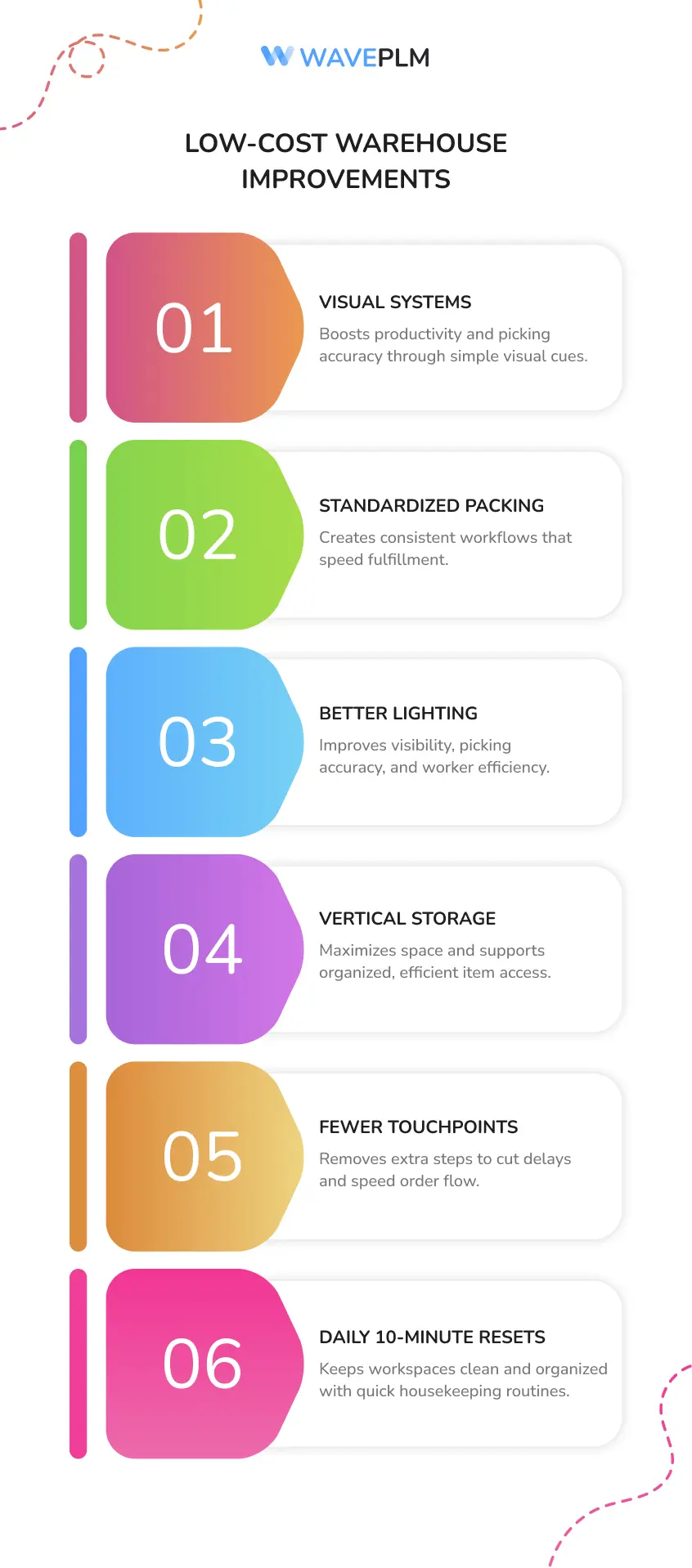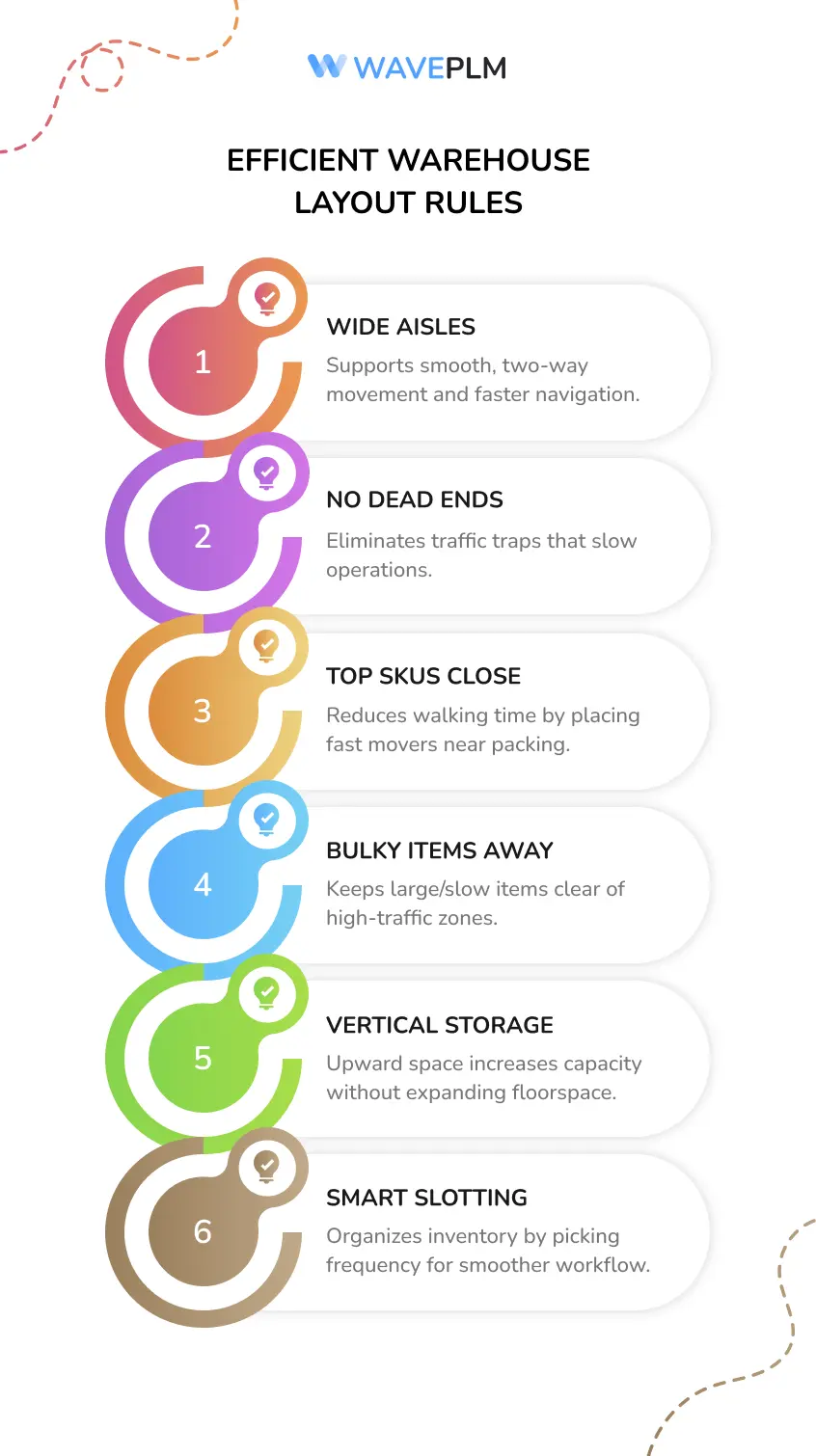
Running an efficient warehouse with a small team may look challenging, but the right strategy—especially one that uses data and KPIs to develop actionable strategies for improvement—turns a limited operation into a strong, predictable workflow. Small warehouses often outperform larger ones when they use smart warehouse improvement ideas, structured inventory management, and consistent warehouse processes.
This expanded guide offers deeper insights, templates, step-by-step frameworks, and more detailed explanations that help you optimize warehouse operations to optimize warehouse efficiency, reduce labor costs, increase productivity, and enhance customer satisfaction.
The goal is simple: help small teams build an efficient warehouse that handles demand, improves inventory accuracy, and maintains high order fulfillment standards—even with limited warehouse space.
Challenges Small Warehouses Face
Small warehouses frequently deal with constraints that impact warehouse efficiency. Limited storage space, fewer warehouse staff members, and higher cycle time create pressure on daily workflows. Understanding these challenges allows warehouse managers to apply targeted solutions that improve efficiency without increasing operational costs.
Main challenges in detail
- Inventory accuracy issues appear when inventory levels lack real time visibility. Incorrect recorded inventory slows order fulfillment and affects customer satisfaction.
- Warehouse layout limitations reduce movement speed, cause congestion, and extend cycle time during the order picking process.
- Rising labor costs result from heavy reliance on manual labor, which impacts labor efficiency and delays order processing.
- Equipment downtime due to unplanned maintenance or equipment failure disrupts workflows, causes operational delays, and reduces overall warehouse efficiency.
- Misplaced inventory items increase picking errors and make inventory control harder for warehouse managers.
- Difficulty measuring warehouse efficiency prevents teams from tracking improvements or identifying performance gaps.
These problems affect warehouse operations and supply chain performance, making it essential to build intentional systems.
Quick diagnostic table
Use this table during weekly reviews to measure warehouse efficiency.
|
Efficiency Factor |
Status |
Notes |
|---|---|---|
|
Clear aisle paths |
☐ |
Improves warehouse safety and reduces cycle time |
|
Accurate inventory data |
☐ |
Ensures real time inventory tracking and reduces errors |
|
Organized storage locations |
☐ |
Helps boost picking accuracy |
|
Defined fast-mover zones |
☐ |
Increases order fulfillment speed |
|
Visual markers |
☐ |
Supports better inventory management |
Low-Cost Improvements
Small warehouses can improve efficiency without expensive automation. These warehouse improvement ideas help reduce labor costs, increase accuracy, and optimize warehouse operations, which also reduces costs overall by minimizing waste and streamlining processes.
1. Use visual systems
Visual aids like labels, arrows, and colored bins give workers instant clarity, playing a key role in boosting productivity. This boosts productivity, improves efficiency, and lowers picking errors.
2. Standardize packing steps
Consistent workflows shorten fulfillment process times and reduce training needs.
Packing Station Template
|
Step |
Action |
|
1 |
Scan item and verify recorded inventory |
|
2 |
Add protective material |
|
3 |
Insert packing slip |
|
4 |
Seal carton and print label |
|
5 |
Move package to outbound loading area |
3. Improve lighting
Bright and consistent lighting enhances accuracy during picking and packing, helping workers identify SKUs faster.
4. Use vertical storage solutions
Maximize space utilization by storing upward and using adjustable racks. Automated storage solutions, such as vertical lift modules or horizontal carousels, are advanced options that can further maximize space in small warehouses. Better usage of existing warehouse space reduces storage costs and improves warehouse storage efficiency.
5. Reduce touchpoints
Each extra step adds friction. Combine tasks when possible, especially for small orders. This helps minimize costs and speed up order fulfillment.
6. Implement daily 10-minute resets
Short housekeeping sessions ensure clean, organized warehouse space. Better organization improves efficiency and supports steady workflow.

Optimal Warehouse Layout for Small Spaces
A well-designed warehouse layout gives small teams major advantages. By making strategic layout choices, you can optimize your warehouse to maximize space utilization and improve workflow. The right structure increases picking accuracy, reduces cycle time, and improves warehouse operations.
Layout rules for an efficient warehouse
- Keep aisles wide enough for smooth two-way movement.
- Avoid dead ends that trap workers and slow operations.
- Place top-moving SKUs near packing to reduce walking time.
- Position bulky or less-frequent items farther from high-traffic zones.
- Use vertical storage solutions to maximize space.
- Apply warehouse slotting to strategically place inventory based on picking frequency and product characteristics, optimizing workflow and storage capacity.

Example layout flow
Receiving → Quality Check → Putaway → Pick Zone → Packing → ShippingThis linear path reduces congestion, improves warehouse efficiency, and increases warehouse productivity.
Zone table
|
Area |
Purpose |
Best Location |
|
Receiving |
Unload and inspect goods |
Near main entrance |
|
Fast Movers |
High-demand SKUs |
Closest to packing station |
|
Reserve Stock |
Seasonal or bulk goods |
Upper or rear shelves |
|
Packing |
Order processing |
Near exit for quick dispatch |
|
Storage |
Bulk or special items |
Along long walls for stability |
How to Prioritize SKUs
Effective SKU prioritization helps optimize inventory levels, improve order picking accuracy, and support inventory management. Optimizing inventory levels can be further enhanced by collaborating with suppliers and using inventory classification techniques to ensure efficient stock control and cost reduction.
Step 1: Rank SKUs by demand
Analyze historical sales data to identify high-motion SKUs, and monitor inventory turnover to assess SKU performance and overall warehouse efficiency. This improves warehouse efficiency and supports better space allocation.
Step 2: Organize by size and fragility
Separate fragile and oversized products to reduce damage and improve warehouse safety.
Step 3: Create SKU tiers
|
Tier |
Description |
Storage Strategy |
|
A |
Fast-moving SKUs |
Keep closest to pick paths |
|
B |
Moderate movers |
Middle shelves |
|
C |
Low-frequency |
Back or top shelves |
Step 4: Run weekly micro-audits to improve inventory accuracy
Small checks maintain inventory accuracy and help inventory control teams align recorded inventory with actual stock.

Measuring Warehouse Efficiency
Measuring warehouse efficiency is a critical step for small teams aiming to optimize warehouse operations, boost productivity, and enhance customer satisfaction. By tracking the right metrics, warehouse managers gain valuable insights into how their warehouse is performing and where improvements can be made. This data-driven approach helps reduce costs, streamline warehouse processes, and ensure that customer demands are consistently met.
Key metrics for small teams
Focusing on the most impactful metrics allows small teams to maximize results with minimal resources. The following key metrics are essential for measuring and improving warehouse efficiency:
- Inventory accuracy: Ensuring that inventory records match actual stock levels is vital for proper inventory management and timely order fulfillment. High inventory accuracy reduces errors, minimizes stockouts, and supports customer satisfaction.
- Order fulfillment rate: Tracking how often orders are picked, packed, and shipped correctly and on time reflects the effectiveness of your order fulfillment process and directly impacts customer satisfaction.
- Labor productivity: Monitoring the output of warehouse staff helps identify opportunities to reduce labor costs and improve labor efficiency. This metric highlights areas where workflow adjustments can boost productivity.
- Space utilization: Making the most of existing warehouse space is crucial for reducing storage costs and optimizing warehouse storage. Efficient space utilization ensures that storage locations are used effectively, supporting faster picking and better inventory control.
Simple tracking methods
Small teams can implement straightforward methods to measure these key metrics and monitor warehouse performance:
- Manual tracking: Use spreadsheets or paper-based logs to record inventory data, order fulfillment rates, and labor productivity. This approach is cost-effective and easy to set up for teams with limited resources.
- Automated tracking: Adopting a warehouse management system (WMS) automates the collection and analysis of real time data, streamlining inventory tracking and warehouse processes. A robust warehouse management system provides real time visibility into inventory levels and order status.
- Regular audits: Schedule routine audits to verify inventory accuracy and ensure that warehouse processes are being followed. Regular checks help maintain high standards and quickly identify discrepancies.
Using data to drive improvements
Once key metrics are being tracked, the next step is to use this data to optimize warehouse operations and drive continuous improvement:
- Analyzing trends: Review historical sales data and warehouse performance metrics to predict future demand and optimize inventory levels. This proactive approach helps reduce associated holding costs and ensures you can meet customer demand.
- Identifying bottlenecks: Use data to pinpoint slowdowns or inefficiencies in warehouse processes, such as delays in picking or packing. Addressing these bottlenecks can significantly improve efficiency and reduce operational costs.
- Implementing changes: Make informed adjustments to warehouse layout, inventory management practices, or staff workflows based on data analysis. Even small changes can lead to measurable improvements in productivity and cost reduction.
- Monitoring progress: Continuously track key metrics to measure warehouse efficiency over time. Ongoing monitoring ensures that improvements are sustained and that the warehouse continues to operate at peak performance.
By consistently measuring warehouse efficiency and leveraging technology solutions like automation and conveyor systems, small teams can enhance accuracy, reduce manual labor, and optimize inventory control. Implementing a robust warehouse management system not only improves real time inventory tracking but also supports better decision-making, helping you boost warehouse efficiency, reduce labor costs, and enhance customer satisfaction.
The Best Tools for Small Warehouses
Small teams rely on tools that increase productivity without increasing operational costs. These technology solutions help manage inventory, reduce errors, and optimize warehouse operations. When choosing a warehouse management tool, it’s important to consider the key features that support efficient tracking, real-time updates, and seamless integration with existing systems.
Core tools
|
Tool Type |
Benefit |
Notes |
|
Barcode scanners |
Improve picking accuracy |
Reduce cycle time |
|
Mobile shelving |
Improve space utilization |
Flexible for layout changes |
|
Digital inventory sheets |
Show real time data |
Improve inventory control |
|
Label printers |
Speed up packaging |
Reduce manual labor |
|
Task boards |
Help warehouse staff stay aligned |
Improve daily planning |
Technology support
- Use warehouse management systems WMS to automate basic warehouse processes.
- Handheld devices create real time visibility for inventory tracking.
- Pre-made templates support labeling, picking, replenishment, and order fulfillment.
These tools support strong warehouse management and improve warehouse efficiency.

Link to WavePLM → How Small Teams Use It
WavePLM supports warehouse managers with tools that optimize warehouse operations and help teams maintain strong inventory accuracy, while also enhancing efficient supply chain operations.
How WavePLM helps
- Centralized product data improves accuracy.
- Real time visibility reduces picking errors.
- Organized workflows improve warehouse management.
- Better inventory management helps meet customer demand.
Small teams use WavePLM to streamline business operations and boost warehouse efficiency.





Leave a Reply